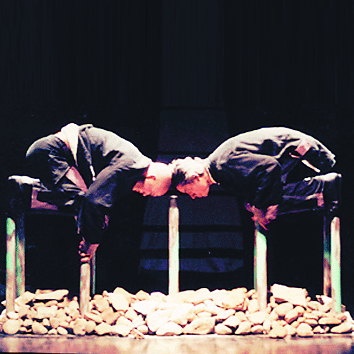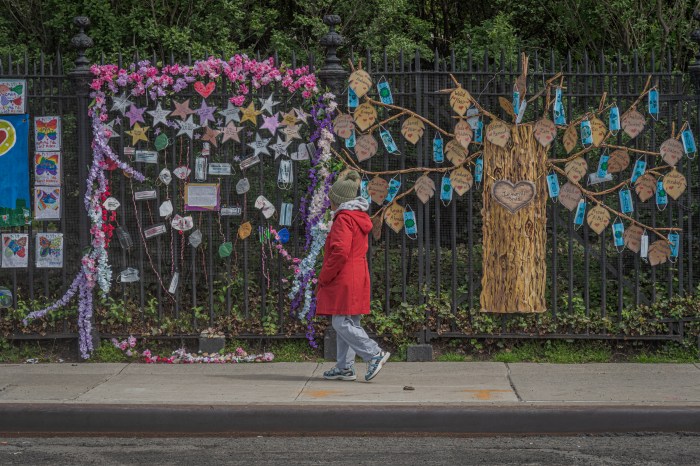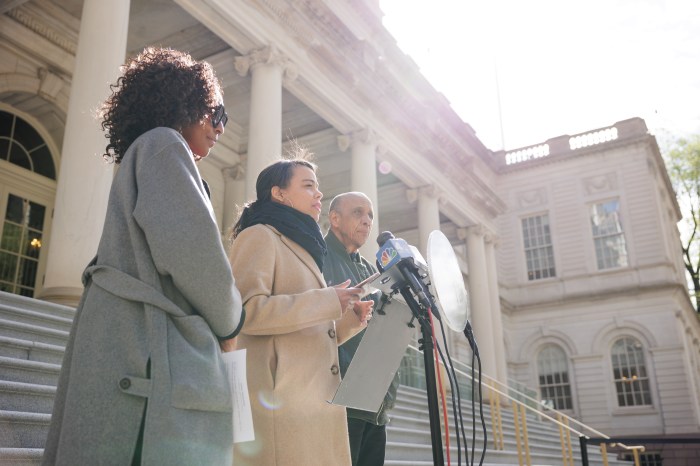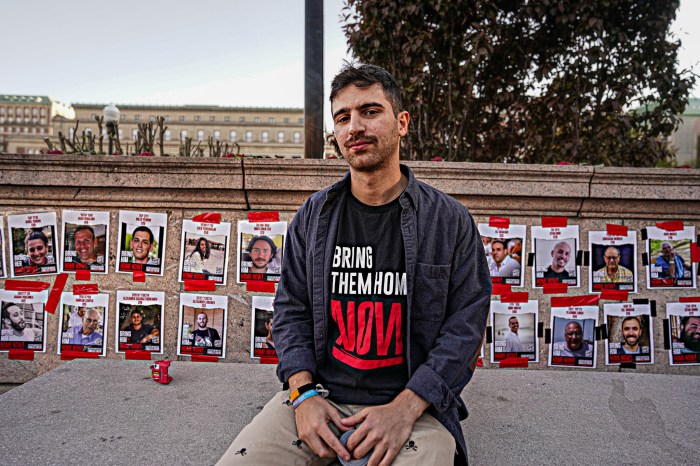Artus echoes recent dance motifs; Ralph Lemon recalls the hoses of oppression
Imagine “Waiting for Godot” with Godot standing there singing the entire time and you’ll have a sense of “Cain’s Hat,” the award winning work by Artus, Hungary’s foremost performance company, presented at the Kitchen October 20 to 23.
A mix of dance, theater, architecture and illusion, it is driven and held aloft by its phenomenal score, entirely sung. Standing ever-present at center stage behind the field of stones where much of the action takes place, Erszi Kiss sings ten-feet tall (on hidden stilts); she is a siren goddess, narrator priestess and Hungarian beat-box dressed in a long, red and white striped conical gown. Birdsong, yodeling, ululating layers of live-over-recorded voice and nothing more produce an entrancing effect that augments the work’s surrealist imagery. Tamás Bakó, Gábor Goda (also the director/choreographer), Bea Gold and Péter Lipka negotiate a series of solos and duets that begins with a simple solo of sharp, angry vocalizations and gestures and progresses to a game of twister on poles.
Props like suitcases that turn into tables, drumsticks and pipes are integral to the piece and are used to build structures to balance on. Hats are used to represent power and there are many conflicts that go literally head to head and seesaw, too. Magic tricks add to the illusionary landscape, simple tricks with fake butterflies and other things with invisible strings. There is a page of program notes referring to Moses and Cain and hats but everything feels aesthetically driven. The dancing itself has a downtown quality, like watching something from five years ago in New York City. Instead of making it feel old, however, it gives the work aura by situating it—at least temporally—within the Diaspora of modern dance.
What makes the pure movement phrases interesting is the martial arts quality, meditative and slow, moving like the air, or sharp, forceful, bone and flesh impacting with aggressive energy and vocal bursts. This Eastern perception is advanced by Kriszta Remete’s costume design, consisting of gray and black collarless three-quarter-length robes with large side pockets and loose-fitting pants or chaps with flaps. Gábor Kocsis’ lighting design is integral to the dreamlike look of the work, and it takes center stage in the final sequence. The garden of stones—not quite Eden—having emptied, the Goddess moves from her station, her face isolated high above the black stage scuttling as if disembodied to and fro, as her calls wane into the darkness.
“Come Home Charley Patton” is intellectual high art, personal essay and profound entertainment. Ralph Lemon’s brilliant final installment in “Geography” is the most clear, most honest and most devastating of his trilogy — a truly great work of American art. Faulkneresque, it is a rich theatrical hypertext, layered in storytelling, dance, video, animation, song and conversation that doesn’t click until the end of the piece. Yet along the way, in performance at the Next Wave Festival at BAM October 26 to 30, we are given the opportunity to change the way we see things. It is a journey that the artist has managed to transfer from his own experience to an audience, and the journey is not always pretty.
An animated James Baldwin appears on a screen above the front of the stage, conversing with the choreographer about video footage in which the choreographer is reading from a book while standing chest deep in the ocean. Unable to remember where exactly it was—Haiti, Georgia or Duluth—the choreographer launches directly into his central question about identity, cultural and racial, public and private. We follow a story across time and space through various characters who seem to shift, although their essence remains the same—a couple, a boy, an event surrounding him.
Choreographic passages show at once a loose unity among the group—Djédjé Djédjé Gervais, Darrell Jones, Lemon, Gesel Mason, Okwui Okpokwasili and David Thomson—and an instability, a literal falling apart. A shuffling of the feet that is charged and familiar and graceful stumbling characterize the movement. The N-word is uttered casually, giving a clue to the shared secret that connects the performers, regardless of their individuality. Later, the marvelously multi-talented Okpokwasili tells a story in which she repeats the word over and over again, Lemon crashing cymbals with each utterance, until finally, the word is exorcized from the stage. It does not resurface anymore when the group dances, and now they fall less often; they have more control of their balance. But the disappearance of words only hides what lies beneath. When the clean white backdrop is pulled away, the choreographer steps into a shallow, plastic-curtained enclosure and a fire hose is turned on him; he continues to dance, even as he slips, his back bearing the force of the water.
Witnessing this act raises the value of the image from its symbolic value and recharges it. It is not a remnant, a newsreel or photograph from the past. It is real and happening here and now. Ultimately, and in this manner, the story brings us full circle to the choreographer on video from the boy lying beneath a lamppost, which marks the spot where a lynching once took place. Like the choreographer, he is trying to connect history to a memory of his own experience. Baldwin echoes again from on high. Dramaturge Katherine Profeta, who collaborated on all three parts of “Geography,” deserves great praise for her work here.
In one inconspicuous but haunting sequence, Gervais places a basketball hoop and net over his head and shoulders. It restricts him, although he does not struggle. It is a potent symbol for a lynching and a potent transformation of sign and the signified that maintains its hold after the performance.
In the lobby, several makeshift backboards made of plywood with their netted round holes hanging high just over our heads. Curiosities coming in, they serve to make a new and deep connection between past and present, there and here, and the geography of Lemon’s imagination expands in our minds as we move back out into the world.



































